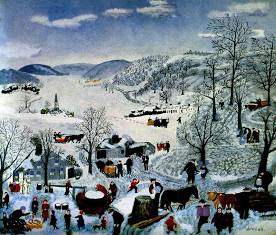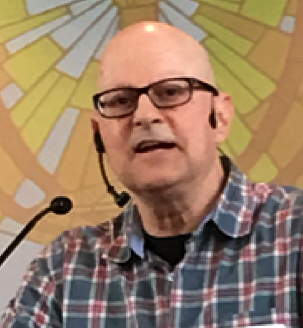In the early 1960s in Los Angeles, I used to ride my three-speed bike several miles down Pico Boulevard, past one of the earliest McDonalds featuring the golden arches (over 1 million served), to downtown, where I would buy a cheap ticket to Saturday afternoon classical music concerts conducted by a young Zubin Mehta at the old Philharmonic Auditorium. Afterward, I would visit the LA County Museum of History, Science and Art. I was intrigued by the work of folk artist Anna Mary Robertson Moses (1860-1961), nicknamed Grandma Moses, and especially by the fact that she didn’t start seriously painting until she was 78 years old! This miscellaneous fact stuck in the back of my brain for the rest of my life.
Grandma Moses’ early years were a typical 19th century story, working hard for wealthy families and then farming with her eventual husband. Only five of their 10 children survived infancy. Later in life, when severe arthritis made embroidery too difficult for Moses, bulkier brush handles allowed her to transform her initial disappointment into a productive career as a painter. She said her father’s encouragement when she was a child led her to make this dream a reality. She made over 1,000 paintings, including 25 pieces after turning 100 years old. Her painting, “Sugaring Off” (pictured here), sold for $1.2 million in 2006.

I can relate to diving into new creative endeavors later in life. I began writing articles for magazines and newspapers in my 30s and taking nature photographs in my 50s. And, when arthritis in my fingers made it too painful to return to the piano or clarinet, I took up playing the harmonica and singing in my 60s. In each instance, I specifically recall reminding myself, “Michael, if Grandma Moses could start something later in life, so can you!” I was also conscious of the fact that I was setting an example for my daughters, and eventually my grandchildren, to emulate.
So, now is an excellent opportunity to turn this time of social isolation into the pursuit of long forgotten childhood passions. Buddhist philosopher and author, Daisaku Ikeda, said, “No matter how wonderful our dreams, how noble our ideals, or how high our hopes, ultimately we need courage to make them a reality. Without action, it’s as if they never existed.”
If we’re not careful, we can be overcome by the belief that we’re too old or not talented enough or that we either can’t or don’t deserve to have some enjoyment in our life when there is so much suffering going on. But, as Moses (Grandma, not the prophet) said, “People should take time to be happy.” By the way, have you ever noticed that the wisest statements make great bumper stickers?
Speaking of wise, Grandma Moses also said, “Now that I am ninety-five years old, looking back over the years, I have seen many changes taking place, so many inventions have been made. Things now go faster. In olden times things were not so rushed. I think people were more content, more satisfied with life than they are today. You don’t hear nearly as much laughter and shouting as you did in my day, and what was fun for us wouldn’t be fun now…. In this age I don’t think people are as happy, they are worried. They’re too anxious to get ahead of their neighbors, they are striving and striving to get something better. I do think in a way that they have too much now. We did with much less.”
The fact that she said this in the 1950s indicates to me that human nature hasn’t shifted that much in 70 years, as evidenced by the materialism, inequality and social discord in our society. This will only improve by reaching people’s hearts. As Ikeda said, “If you want to change another person, first change your own heart. When you change, others around you will change.”
It’s up to each of us, in our own unique way, to actualize and share our creative potential. So, let the arts and humanities (and social justice) continue!
Thanks for reading and let’s stay safe out there.
Other titles by Mike during Covid-19:
Leonardo da Vinci & the Coronavirus
Lean on Bill Withers and Defeat the Coronavirus
Gandhi, King, Ikeda & the Coronavirus
Annie Leibovitz and the Coronavirus
Ansel Adams and the Coronavirus
Louise Penny and the Coronavirus
Harry Manx and the Coronavirus
Davy Jones and the Coronavirus
Prince Hamlet and the Coronavirus
Helen Keller and the Coronavirus
Pema Chodron and the Coronavirus

ABOUT MIKE LISAGOR – Mike Lisagor plays harmonica and sings in Good Karma Blues. He has written hundreds of magazine articles and blogs on a variety of business and Buddhist related topics. He is the author of “Romancing the Buddha,” which he adapted into a successful one-man show that he performed at Bainbridge Performing Arts and in Los Angeles and Washington D.C. His nature photographs have appeared in the Boston Globe, Bainbridge Island Magazine, Living Buddhism as well as in several local galleries. His latest graphic art project, “Reimagined Nature”, is in the lobby of New Motion Physical Therapy.